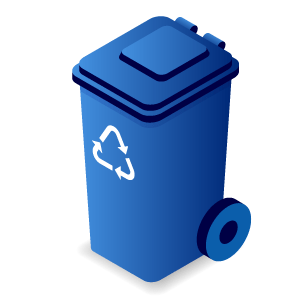Cardboard recycling: Your guide on how to recycle cardboard

Cardboard, along with paper, is one of the easiest materials to recycle in the UK. Sorting and recycling cardboard means avoiding putting further strain on our planet’s natural resources, and, therefore, reduces our carbon footprint. In this guide, find out all you need to know about recycling cardboard.
I stand up for real climate action, I offset my CO2 emissions!Global warming is everyone's business! To offset your CO2 emissions and participate in the energy transition.
Send us an e-mail
How is cardboard recycled?
Cardboard is one of the most efficient materials to recycle compared to what is needed to make it from scratch - including wood and using chemicals which could be harmful for our environment.
What is recycling?Recycling refers to the collection of waste and its reintroduction into the production cycle after treatment.
There are many ways to recycle cardboard in the UK, including kerbside recycling or taking your cardboard to a cardboard recycling centre. Whichever option you choose, the cardboard recycling process is the same once you dispose of it.
- Cardboard collection: Councils across the country provide recycling bins in which you can separate your recycling - glass, cardboard, organic, etc. Once collected, the recycling process can begin;
- Storage: Cardboard and paper is taken to a paper mill or recycling centre where it is stored to be sorted later;
- Decontamination and pulp: Via a process in which the cardboard is submerged in water soap, any ink and other substances that can not be recycled are removed. When cardboard and paper are soaking wet and soggy, it is known as pulp;
- Drying and removing of sludge: The pulp is then put through a drying process and any sludge (waste) removed and disposed of as a by-product;
- Ironing: A calendar stack irons out the recycled cardboard into paper rolls. Some of this will remain as paper - for newspapers, for example, while some it will go onto to become new cardboard boxes;
- Measured and prepared: The newly recycled paper or cardboard is measured and prepared, ready for re-use;
- Finished product: Recycled cardboard boxes can be used again.
How to recycle your cardboard?
Fortunately, there are many ways you can recycle your paper and cardboard in the UK. One of the most obvious ways is to use the recycling bin provided by your local council.

Depending on the area of the country in which you live, it may be a different colour, but they are normally blue bins. Likewise, some councils provide bins for cardboard and paper waste only when others collect it as part of the mixed recycling collection. As a starting point, it is best to get in touch with your council to find out what bin you should use and what days it will be collected.
There are often some doubts as to what items can be included in paper and cardboard recycling. Most councils in the UK will accept all of the following items to be recycled:
- Cardboard boxes;
- Cardboard food packets;
- Greeting cards;
- Toilet roll tubes and kitchen roll tubes;
- Empty food and drink cartons - make sure you remove any liquid beforehand;
- Tetrapaks;
- Newspapers and magazines;
- Catalogues, telephone directories and paperback books;
- Envelopes and junk mail.
Where can I take my cardboard recycling?
In addition to kerbside collections, you can also take your cardboard to your local recycling centre. If you are unsure where that is, a search online for ‘cardboard recycling center near me’ or ‘cardboard recycling near me’ will show you your best options.
Supermarkets, sports centres and other buildings with high footfall usually have recycling bins for all sorts of items, including cardboard and paper.
What should I do before recycling cardboard?There are many ways you can help the cardboard recycling process be more efficient. Some of the things you can do include removing any tape from the cardboard box, or any other non-cardboard items that may contaminate. You should also try and ensure any boxes are broken down to be flat.
If you have large amounts of cardboard recycling, perhaps after moving house, for example, you could always consider calling a private waste management company such as Business Waste, who will arrange to take cardboard items away.
Cardboard recycling logos
To facilitate the recycling of cardboard, it is important to know the different logos of the cardboard containers that we use on a daily basis.
| Symbol | Meaning |
|---|---|
|
Mobius Loop 
|
A general and widespread symbol indicating that the packaging is recyclable. |
|
The Green dot 
|
It means the packaging producer has made a contribution towards packaging recycling. However, it does not necessarily mean the packaging itself is recyclable. |
|
Widely recycled 
|
This symbol is used on packaging that is collected by at least three quarters (75%) of local authorities across the UK. It can be used on all recyclable items, including glass, plastic, paper, and cardboard. |
|
FSC 
|
The Forest Stewardship Council logo is on all packaging or products which contain wood from well managed forests. |
|
Corrugated recycles 
|
This symbol, developed by the International Corrugated Case Association, indicates that corrugated cardboard packaging can be recycled. |
The benefits of recycling cardboard
By recycling paper and cardboard, we can do our part to improve the environment, protect the planet, and reduce our carbon footprint. These are just some of the many benefits of recycling cardboard:
- Saves trees: By recycling cardboard, fewer trees need to be cut down, reducing the impact of deforestation. Trees also play an important role in storing carbon dioxide (CO2), so we should do all we can to avoid cutting them down;
- Saves energy: It takes a lot more energy to use raw materials and make paper or cardboard from scratch compared to recycling it;
- Reduces landfill: One of the key benefits to recycling cardboard is that it reduces the amount of waste sent to landfill. According to the Department for Environment, Food and Rural Affairs (DEFRA), the average person in the UK sends around 400 kg of waste to landfill every year - around 7 times their body weight. Landfill has a big impact on the local environment, including both air and water pollution, so we should do what we can do to send less items to landfill;
- Reduces greenhouse gases: Landfill sites are huge producers of greenhouse gases. When cardboard is sent to landfill, as it breaks down it releases methane, one of the most harmful greenhouse gases, into our atmosphere.

Don't know what your company can do for the planet?
Contact our carbon offset department and we will advise you.
Paper and cardboard recycling facts
As it is one of the easiest items to recycle, it should come as no surprise that in the UK, around 80% of cardboard and paper is recycled, according to data published by Statista. However, here are some other facts you may not have been aware of:
- In 2021, Statista data showed there were approximately 4.2 billion parcels were sent in the UK. This was an increase of over 1.3 billion parcels from the previous year;
- Paper and card make up 20% of all waste we throw away in the UK every year;
- For every tonne of paper recycled, there is a huge amount of the world’s resources saved, including 380 gallons of oil and 7000 gallons of water;
- UK households throw away 227,000 miles of rolls of wrapping paper every Christmas. That’s enough to cover 11,000 football pitches.
Source: Recyclingbins.co.uk.
- Discover all our other guides on recycling
- Aluminium recycling: How and why to recycle it?;
- Glass recycling: Your guide on how to recycle glass items;
- Composting: What is it and how to start?;
- Clothing recycling: How to recycle old clothing?;
- Plastic recycling: Your guide on what plastics can be recycled;
- Paper recycling;
- Tyre recycling: Where to dispose of them?.
